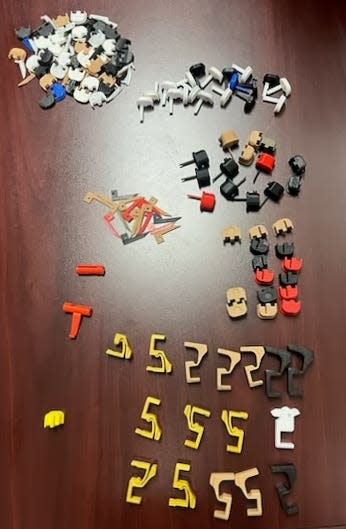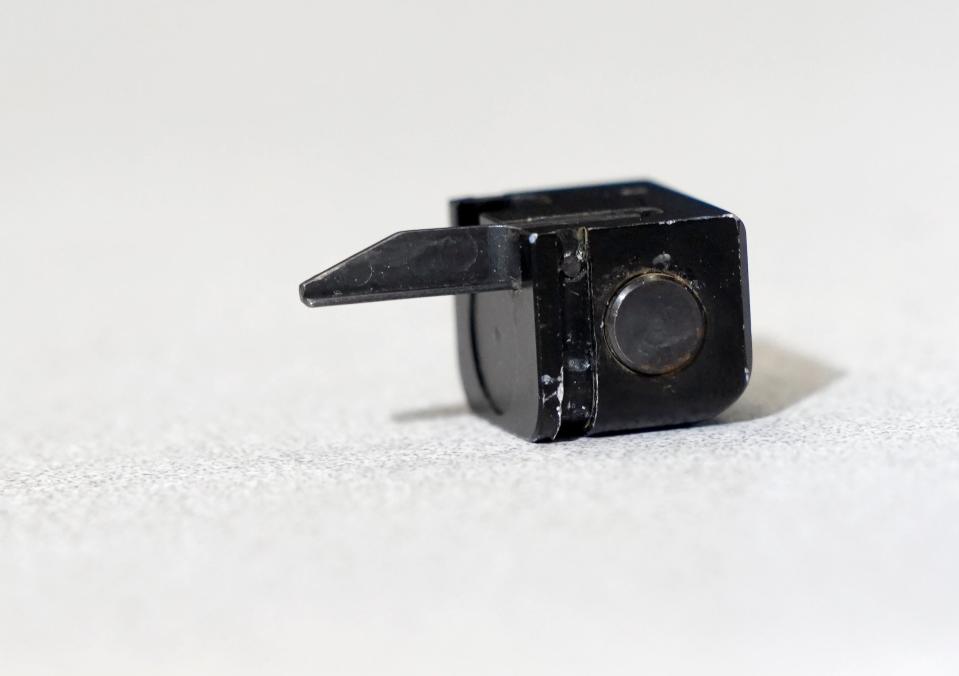3D-printed machine gun conversion devices, long a scourge in major cities, hit Evansville
EVANSVILLE –– Just months after Vanderburgh County set up what it called a Crime Gun Intelligence Center, officials claim the agency helped seize more than 60 “machine gun conversion devices” and an abundance of illegally produced firearms components, some of which an Evansville man allegedly made using 3D printers.
The Jan. 31 seizure highlights the growing popularity of 3D-printed gun parts and their use by criminals. Some of the devices can convert a semi-automatic weapon into what is, effectively, a small machine gun, while others seek to emulate sound suppressors and hard-to-obtain mechanical components.
The most common illegal gun part produced this way is often referred to as a "switch," though in fact it is an auto sear – a device that allows a firearm's bolt to cycle repeatedly with just one pull of the trigger.
"They basically turn a handgun into a machine gun," said Vanderburgh County Prosecutor Diana Moers, who told the Courier & Press she could not discuss details pertaining to the recent bust. "Getting many of these off the street through the (Crime Gun Intelligence Center) is going to be something that's really important to us."
More on CGIC: Local law enforcement unveils new tool to track guns used in violent crimes
The so-called "switches" constitute one of the illegal gun parts law enforcement allegedly seized from 38-year-old Marquel Payne during searches of his Cedar Street home and a U-Haul truck. The police also claimed to have found 3D printers and printing supplies stashed inside a North Seventh Avenue home.
A list of items seized, as compiled by the Evansville-Vanderburgh County Joint Task Force, illustrates the scope of Payne's alleged operation:
63 Machine Gun Conversion Devices (MCDs)
9mm Ghost Gun
Pac West Arms 5.56 AR-15
Bambu Lab P1P 3D Printer
Printing Filament
Misc. Printed Pieces
3D-Printed Suppressor
9mm Ammunition
Unfinished (machine gun conversion device) parts

The police also allegedly seized drugs, a laptop, a tablet, and two cell phones from properties affiliated with Payne. The task force operation led to the arrest of a second man, Antonio D. Carey, on charges of dealing in methamphetamine and unlawful possession of a firearm by a domestic batterer, according to court records.
Payne faces multiple counts of possession of a machine gun and possession of a firearm by a domestic batterer. While state prosecutors charged both men, cases involving illegal gun parts are often transferred to federal courts.
In September, a federal judge in Indianapolis sentenced 31-year-old Micah Moore to serve seven-and-a-half years in prison after he pleaded guilty to possession of a machine gun. Prosecutors alleged that Moore used 3D printers to manufacture "switches," which he later sold for a profit.

What are 'switches,' or machine gun-conversion devices?
A quick YouTube search for the term "Glock with a switch" returns a flood of results depicting young people proudly brandishing what appear to be standard firearms − usually handguns − as they cruise city streets or explore barren farmland across the United States late at night, eager to squeeze off a few rounds without drawing attention.
But when the videos' protagonists engage their weapons’ triggers, mayhem ensues. A torrent of bullets stream out in all directions at more than 1,000 feet per second: rounds slam into the dirt, launch into the night sky and ricochet through trees not far from sleepy subdivisions, according to a Courier & Press review of public video footage.
That's because the weapons in question are not the kind most Americans legally procure from a local gun store. These are modified firearms illegally altered to fire fully automatic – meaning the weapon will cycle, and therefore fire, so long as the shooter holds down the trigger.
The National Firearms Act of 1934 outlawed civilian possession of machine guns under most circumstances, and Congress updated the act in 1986 to ban machine gun conversion devices like those seized in Evansville.
Such conversions, which often involve pistols manufactured by the Austrian firm Glock, have long plagued cities such as Chicago, where rampant gun violence claims hundreds of lives each year despite strict gun-control laws. The rise of affordable 3D printers, which can now be had for less than $1,000, and the proliferation of filesharing websites means it's easier than ever for criminals to produce machine gun-conversion devices at home.
In an unmodified Glock pistol − such as the 9mm Glock 17 model employed by Evansville police − a trigger bar engages the rear portion of the firing pin and prevents it from moving forward and striking a loaded cartridge. When a shooter pulls the trigger on a semi-automatic Glock, the trigger bar lowers down a safety ramp and releases the firing pin, which in turn strikes the loaded cartridge’s primer and fires a round down range.
Once fired, the trigger bar resets and stops the firing pin from striking a second cartridge.

An auto sear, or switch, disrupts this process and effectively neutralizes the action of the trigger bar, allowing the weapon to fire repeatedly, in rapid succession, so long as the shooter keeps the trigger depressed.
Glock switches: 5 questions answered about the devices showing up at Indy crime scenes
The appeal of such a device may seem self-explanatory: More rounds down range means a more effective weapon and, for the hobbyist, more fun, right? Not necessarily.
"Even the military, they don't use fully automatic pistols," Sgt. Michael Gray of the Evansville Police Department told the Courier & Press. "It is very concerning. They're going to be literally emptying a magazine of rounds and maybe pointing in the direction (but) not even aiming using the sighting system on the gun… Yeah, there's going to be some issues with where the rounds go."
Gray, who works within the EPD's Narcotics Unit, said machine gun-conversion devices had "sporadically" cropped up in Evansville since he joined the force in 2005, but officers are encountering the devices more frequently.
What began as a gun crime trend in larger metros, such as Chicago and Indianapolis, years ago trickled down to Evansville over time, according to Gray.
"We're usually just a little bit behind," he explained. "We're starting to see these more and more … They're not common yet, depending on what your definition of 'common' is."
Houston can be contacted at houston.harwood@courierpress.com
This article originally appeared on Evansville Courier & Press: What is a Glock switch? Are Glock switches being made in Evansville?

